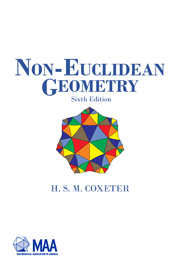Crossref Citations
This Book has been
cited by the following publications. This list is generated based on data provided by Crossref.
Pambuccian, Victor
2000.
Binary relations as single primitive notions for hyperbolic three-space and the inversive plane.
Indagationes Mathematicae,
Vol. 11,
Issue. 4,
p.
587.
Ungar, Abraham A.
2001.
Beyond the Einstein Addition Law and its Gyroscopic Thomas Precession.
p.
381.
Blake, Stephen
2002.
Applications of Geometric Algebra in Computer Science and Engineering.
p.
47.
Ferguson, Helaman
and
Ferguson, Claire
2003.
M.C. Escher’s Legacy.
p.
166.
Saliola, Franco
and
Whiteley, Walter
2004.
Constraining Plane Configurations in CAD: Circles, Lines, and Angles in the Plane.
SIAM Journal on Discrete Mathematics,
Vol. 18,
Issue. 2,
p.
246.
Alexander, Ralph
Berg, I.D.
and
Foote, Robert L.
2005.
Integral-Geometric Formulas for Perimeter in $\S^2$, $\H^2$ and Hilbert Planes.
Rocky Mountain Journal of Mathematics,
Vol. 35,
Issue. 6,
Ruoff, Dieter
2005.
Why Euclidean Area Measure Fails in the Noneuclidean Plane.
Mathematics Magazine,
Vol. 78,
Issue. 2,
p.
137.
Prékopa, András
2006.
Non-Euclidean Geometries.
Vol. 581,
Issue. ,
p.
3.
Modes, Carl D.
and
Kamien, Randall D.
2007.
Hard Disks on the Hyperbolic Plane.
Physical Review Letters,
Vol. 99,
Issue. 23,
Modes, Carl D.
and
Kamien, Randall D.
2008.
Geometrical frustration in two dimensions: Idealizations and realizations of a hard-disk fluid in negative curvature.
Physical Review E,
Vol. 77,
Issue. 4,
Hart, George W.
2008.
Sculptural forms from hyperbolic tessellations.
p.
155.
Kleman, M.
and
Friedel, J.
2008.
Disclinations, dislocations, and continuous defects: A reappraisal.
Reviews of Modern Physics,
Vol. 80,
Issue. 1,
p.
61.
Ghali, Sherif
2009.
Sense and sidedness in the graphics pipeline via a passage through a separable space.
The Visual Computer,
Vol. 25,
Issue. 4,
p.
367.
Ringermacher, Harry I.
and
Mead, Lawrence R.
2009.
A new formula describing the scaffold structure of spiral galaxies.
Monthly Notices of the Royal Astronomical Society,
Vol. 397,
Issue. 1,
p.
164.
Hart, George W.
2009.
An Algorithm for Constructing 3D Struts.
Journal of Computer Science and Technology,
Vol. 24,
Issue. 1,
p.
56.
Boeyens, Jan C. A.
2010.
Chemical Cosmology.
p.
1.
Kaisari, Maria
and
Patronis, Tasos
2010.
So we decided to call “straight line” (…): Mathematics students’ interaction and negotiation of meaning in constructing a model of elliptic geometry.
Educational Studies in Mathematics,
Vol. 75,
Issue. 3,
p.
253.
Liu, Ying
Liu, Bihui
Liu, Yue
and
Drew, Michael G. B.
2011.
Correlations between two sets of angular relation equations.
Journal of Mathematical Chemistry,
Vol. 49,
Issue. 9,
p.
2089.
Ouyang, Peichang
Cheng, Dongsheng
Cao, Yanhua
and
Zhan, Xiaogen
2012.
The visualization of hyperbolic patterns from invariant mapping method.
Computers & Graphics,
Vol. 36,
Issue. 2,
p.
92.
2013.
Introduction to Topology and Geometry.
p.
497.



